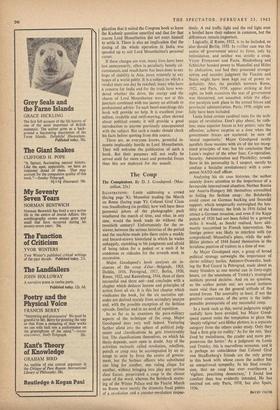The Coup
ILLUSTRATIONS : Lenin addressing a crowd (facing page X); Mussolini leading the March on Rome (facing page Y); Colonel Graf Claus von Stauffenberg (in profile); how well have these perennial jokers of the photographic pack weathered the march of time, and what, in any case, would the book trade do without the twentieth century? Unfortunately for the re- viewer, between the serious histories of the period and the machine-made jobs there exists a muddy and hazard-strewn hinterland in which he wades unhappily, stumbling in his judgments and afraid of being taken for a pedant or a snob if he condemns or ridicules for the seventh week in succession.
Major Goodspeed's book analyses six in- stances of the coup d'etat—Belgrade, 1903, Dublin, 1916, Petrograd, 1917, Berlin, 1920, Rome, 1922, and Rastenburg, 1944, three of them successful and three not—and concludes with a chapter which deduces lessons and principles of action from all six. It is this last chapter which vindicates the book, for the six narrative epi- sodes are derived mainly from secondary sources and, with the possible exception of the Serbian episode, familiar and in no need of repetition.
In so far as he examines the para-military aspects of the technique of the coup, Major Goodspeed does very well indeed. Venturing farther afield into the sphere of political judg- ments and classifications he gets irretrievably lost. The classifications themselves, on which his thesis depends, seem open to doubt. Any of the activities variously called revolution, rebellion, putsch or coup may be accompanied by an at- tempt to seize by force the centre of govern- ment, but the Serbian officers who substituted one king for another, one ruling clique for another, without bringing into play any serious class forces, perpetrated a coup in the closest sense of the word, whereas the Bolshevik storm- ing of the Winter Palace and the Fascist March on Rome were merely the dramatic focal points of a revolution and a counter-revolution respec-
tively. A red traffic light and the red light over a brothel have their redness in common, but the differences remain important.
Logically, if Rome, 1922, is to be included, so also should Berlin, 1933. In neither case was the centre of government seized by force, only by intimidation, and neither was strictly a coup. Victor Emmanuel and Facta. Hindenburg and Schleicher handed power to Mussolini and Hitler by abdication, and had they possessed stronger nerves and sounder judgment the Fascists and Nazis might have been kept out of power in definitely. Also, the parallels between Rome, 1922, and Paris, 1958, appear striking at first sight; on both occasicns the seat of government was threatened, not assaulted, while the effec- tive paralysis took place in the armed forces and provincial administration. Paris. 1958, might use- fully have been included.
Lenin listed certain cardinal rules for the tech- nique of revolution. Don't play about, be ruth- less; mass superior forces at key points; take the offensive; achieve surprise at a time when the government forces are scattered; be sure of 'moral superiority.' Major Goodspeed neatly parallels these maxims with six of the ten recog- nised principles of war, but his conclusion that Lenin's neglect of the other four, Co-operation, Security. Administration and Flexibility, reveals flaws in his personality is, 1 suspect, merely to confuse a Socialist revolutionary with a com- petent NATO staff officer.
Analysing his six case histories, the author astutely draws attention to the importance of a favourable international situation. Neither Russia nor Austria-Hungary felt themselves committed to foiling the Serbian coup: the Bolsheviks could count on German backing and financial support, which temporarily outweighed the hos- tility of the Entente; the Irish in 1916 failed to attract a German invasion, and even if the Kapp putsch of 1920 had not been foiled by a general strike it would, as Seeckt realised, have ulti- mately succumbed to French intervention. No foreign power was likely to interfere with (or comprehend) Mussolini's plans, while the anti- Hitler plotters of 1944 found themselves in the invidious position of traitors in a time of war.
As Major Goodspeed says, a grasp of broad political strategy outweighs the importance of clever military tactics. Antonov-Ovseenko, lead- ing the Red Guard in Petrograd, made about as many blunders as one mortal can in forty-eight hours, yet the soundness of Trotsky's strategical instincts proved decisive. And on no question, as the author points out, are sound instincts more vital than on the general attitude of the armed forces. The neutrality at least, if not the positive connivance, of the army is the indis- pensable prerequisite of any successful coup.
In a book such as this, moral judgments might usefully have been avoided, but Major Good- speed cannot resist the temptation to place the 'deeply religious' anti-Hitler plotters in a separate category from the others under study. Only they 'had a firm grip on reality.' As for the rest, 'they lived by melodrama, the cruder and more pre- posterous the better.' As a judgment on Lenin and Trotsky, this is marvellous nonsense, and, it is perhaps no coincidence that Colonel Graf von Stauffenberg's friends are the only group in this book with whose cause the author has an unequivocal sympathy. In his final conclu- sion, that no coup has ever overthrown a 'vigilant, practising democracy,' I found less comfort than was evidently intended. He has omitted not only Paris, 1958, but also Spain, 1936.
DAVID cAurs


































 Previous page
Previous page